Fight rising food costs by growing veggies from scraps—here’s how
No garden? No problem
Products are chosen independently by our editors. Purchases made through our links may earn us a commission.
Food prices keep going up. Wouldn’t it be nice to have food that magically regrows after you eat it? Well, growing vegetables from scraps isn’t magic, but you can save some money and enjoy growing food at home, even if you don’t have a yard.
Vegetables and herbs ranging from lettuce to basil can all be grown from kitchen scratch at home. Here’s how to do it.
How to grow vegetables from scratch: What can I repurpose?

Placing scraps in a clear vase or bowl with a little bit of water can kickstart a sprouting cycle.
Globe onions and garlic
There are two ways of growing onions from scraps: Removing existing sprouts, or sprouting the heart.
If your onion is already sprouting, cut away the material around the sprouts. Be careful. You want to keep the top sprout(s) intact, and you want to keep them connected to the bottom root —the little round area with small hairs or dirt at the bottom of the onion.
If your onion has more than one sprout, you can either treat all the onion’s sprouts as one clump, or carefully peel them apart, starting at the top of the bulb.
Place your sprouts root-side-down in water, and wait for more roots to sprout, then plant them in a container or outside.
If your onion doesn’t have sprouts, you try the same procedure with the onion’s heart—the center section of the onion. Just make sure that you keep the bottom root attached.
Got sprouting garlic? Just plant it about 1-inch deep in soil, sprout side up.
Green onions, scallions, leeks, and chives
Green onions, leeks, and chives are easy to resprout. Eat as much of the green part as you like, then put the white part in water, root-end down.
These should sprout new roots in a few days on a sunny windowsill.
Sweet potatoes
Sweet potatoes will sprout if they’re suspended in water.
Cut your sweet potato in half and suspend it over water; plant it once roots emerge. You can use toothpicks or skewers to hold it over the water, or use a hyacinth vase.
Potatoes
Resprouting supermarket potatoes can be tricky, because they are often treated with a sprout inhibitor. These may also carry plant diseases that can kill potatoes or closely-related plants, including tomatoes.
If your potatoes are already sprouting, though, or you’re not going to be planting them near other plants you care about, give it a try.
Cut your potato intro pieces with at least one eye (sprout) each. Plant those potatoes in a container or in the soil, water, and wait for the sprout to appear.
Leafy greens
You can use the same technique for growing leafy greens from scraps including bok choy, cabbage, fennel, and lettuce. You can even grow celery, too, although most people eat the celery stems, not the leaves.
Put the bottom inch of the base and root end of the greens in a shallow bowl of water, and change it daily. When new leaves start to grow, move your new plant to a permanent home in a container or in the ground.
Pineapples
In theory, you can grow a pineapple from scraps by taking the top half-inch of the pineapple (below the leaf cluster, plus its top) and let it dry for a few days, according to the University of Illinois Extension.
Plant it in a container in a potting mix that drains well, water it, and put it in a sunny place. It may take two to three years to develop.
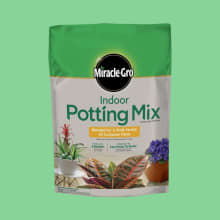
A bag of potting is always great to have on hand, especially one that's nutrient-dense.
Avocados
While avocados don’t resprout, you can grow a new avocado tree from the pit.
To start growth, suspend the pit in a jar so it’s half-submerged in water. The classic method is to stick toothpicks into the sides that extend over the jar’s rim. Or, you can use a hyacinth vase to keep the bottom in water.
Over a few weeks a small shoot will emerge; then, a shoot with small leaves; then, the main stem.
Plant your avocado plant in soil once the main stem emerges.
If you don’t see pineapple or avocado trees growing outside in your climate, you’re very unlikely to ever get pineapples out of this new plant unless you invest in a greenhouse or a powerful plant light system.
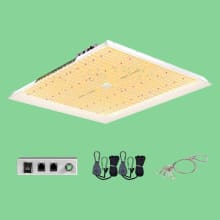
This strong grow light will keep plants happy and healthy, even in the darker winter days indoors.
Cilantro and basil
In theory, you should be able to grow basil and cilantro from cut leaves. The University of Michigan extension recommends using a leaf stalk that's four to six inches long.
However, as anyone who has tried to keep cut flowers fresh knows, underwater stems can start rotting very quickly if you don’t change the water frequently. Consider changing the water for these herbs at least once a day.
Ginger root
Most imported supermarket ginger root is treated with a sprouting inhibitor, but it’s worth trying to sprout if you can find organic ginger or if you spot it at a seed store.
Cut a piece about three inches long with three or more buds on it and let it dry for a few days until the cut area no longer looks wet.
Put the ginger in a pot, and water it. Keep it a little dryer than other plants, watering just once a week until sprouts appear, which can take several weeks.
With enough watering, light, and heat, your ginger plant will grow stems up to three feet tall.
How to grow vegetables from scratch

This easy-to-use propagation station can be use on a kitchen counter, window sill, or a desk.
The basic method for growing vegetables from scraps is to put either the root or stem of the vegetable in water, and wait. Put the scraps where there is good light and circulation in your home, like a windowsill. A south-facing window is best. Make sure the windowsill is high enough off the ground that inquisitive pets won’t be tempted to snack on it or knock it to the floor.
Use glass jars, vases, or bowls for your vegetable scraps so you can see changes in the water and observe when the roots start growing. If you prefer something more decorative, this stand with five jars is a little more tip-resistant and portable than most olive jars.
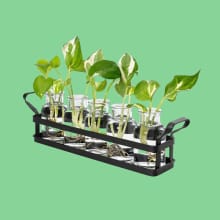
This stand comes with glass bottles and a stylish stand for decorating and propogating.
You can also get glass jars that sit on a flat board or dangle from a folding wooden stand.
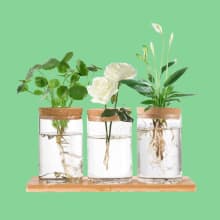
Three glass jars sit on a flat board for unobtrusive propagating in your kitchen, on your windowsill, or wherever you have space.

This space-saving design is perfect for propagating on your desk for a pop of green while you work.
For vegetable scraps that need to be suspended over or partly in water, you can use a hyacinth vase or acorn glass.
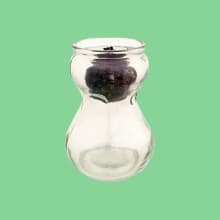
A simple glass vase can help any propagated plant grow, especially if it needs a little more attention.
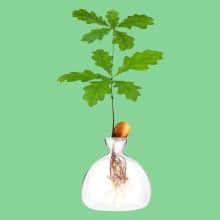
Even hearty plants like avocados need special growing conditions to remain healthy. This vase helps keep them happy.
You also want to change the water when it becomes cloudy or turns a different color. The rate at which it needs to be refreshed will vary, but keep an eye on it every day in order to ensure optimum growth for your vegetable scraps.
Over the course of a week or two, you should see new roots and leaves emerging from your growing vegetable scraps. Then, it’s time to either put your new plant in a container or the ground, or eat it!


